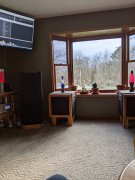pennysdad
Veteran and General Yakker
- Joined
- Feb 27, 2013
- Messages
- 3,728
- Location
- In witness protection.
- Tagline
- I've totally lost the plot....
This looks like an opportunity for me to ask some questions...
I want a subwoofer! I like my ADS 1290 speakers, except one thing: they’re a bit thin on the bass. I can drive them harder with an EQ, but then I hit a limit to the cone excursions.
I’ve been looking at a Klipsch (recommend another, if you want..) sub. I see that they have connections from the amp and then to the speakers. This is an active xo, correct? Or should I connect the pre out to an active xo and feed two separate outputs (now that I have two amps). For the second option, I want to keep the higher bass directed to the 1290s, and the extreme bottom to the sub- I suppose these xos are tunable?
I have no experience with these, as I’ve said before, I’m curious to hear your thoughts. Thanks!
Look for a JBL 2235 15" speaker. They can go to 17Hz in a properly tuned box. It's what I use. Now the funny thing is, most wouldn't know the difference between 45Hz and 20Hz let alone 17Hz. In reality, you can't really appreciably hear below 20Hz regardless of those that would argue they can. Although you can't 'hear' it, you can 'feel' it, and lower. That's where the 'magic' lies. But 45Hz is a 'happy' frequency. It's where most bass is appreciated and can be heard easily, and usually it's enough. Although once you've experienced lower registers it's hard to accept anything else.
I have this Chinese 10" baby sub, and it's tuned to 35Hz, and damn it sounds great. Go figure. I guess because it suits lots of stuff that's recorded these days, but my big JBL B380 with the 2235 really kills it, but until you turn the JBL on, the 10" is usually more than adequate.
... and yes, active x-o's are generally always tuneable. Try and find an old DBX Driverack [PA or 260]. Fairly straightforward bit of kit and can do heaps and has great specs. https://www.manualslib.com/manual/452242/Dbx-Driverack-Pa.html

Last edited:

